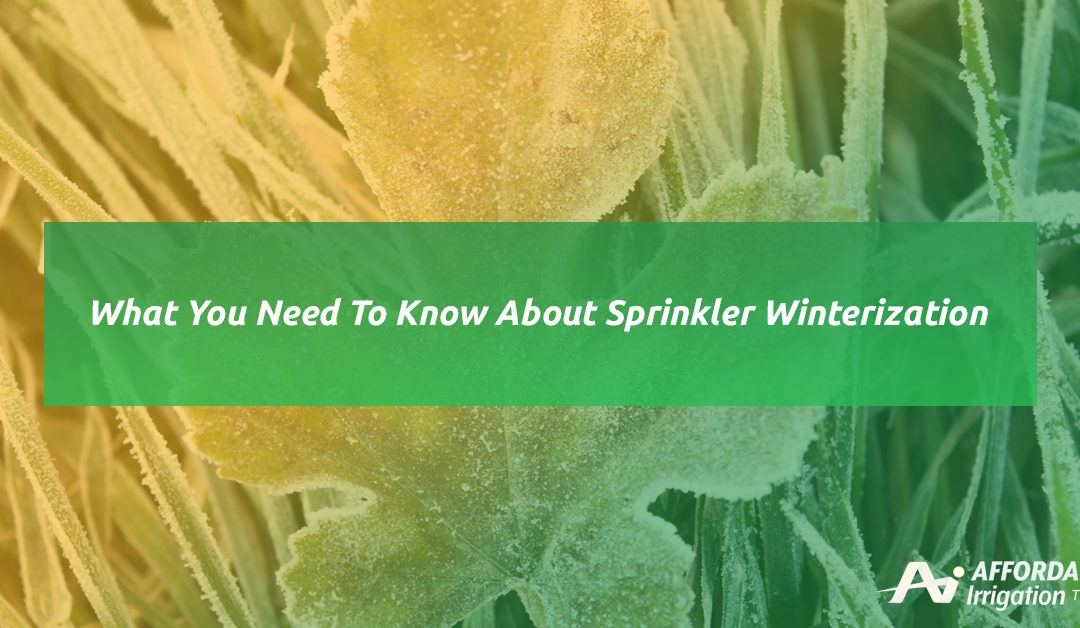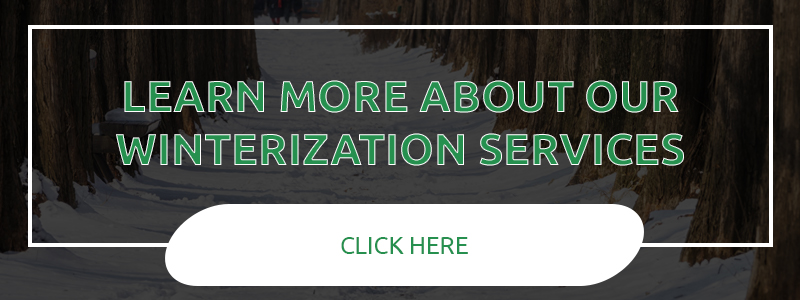Winter is coming, and although Tulsa doesn’t get the worst winters in the world, they’re not exactly sunshine and rainbows either. Any Oklahoma resident is familiar with the dipping temperatures and snowfall that we experience throughout the winter seasons, and now that we’re coming up on Christmas, fall will soon be on its way out.
Winterization is a very important process that many devices have to go through, whether they’re large vehicles or simple outdoor appliances. Your sprinkler system is no exception, and is actually one of the most important things to prep for the cold season.
Your sprinklers channel water through them throughout the year, which makes them extra susceptible to the cold — the moisture inside could end up freezing, which can cause major problems if you’re not prepared for it.
Let’s take a look at everything you need to know about winterization, and how our sprinkler system company can help.
What Happens If You Don’t Winterize Your Sprinkler System
The first thing that’s important to understand is what exactly happens if you don’t winterize, and which components are in the most danger. While most people like to hold off on calling professionals unless it’s absolutely necessary, the choice to winterize becomes a lot more tempting when they realize how expensive repair costs would be if their system froze.
Frozen Backflow
The biggest risk you run by not winterizing is your backflow preventer freezing. The problem here is that freezing tends to warp the components, causing permanent leaks.
What is a backflow preventer?
For the uninitiated, a backflow preventer is a handy little component in your pipe system which allows water to go in one direction, but not the other. Irrigation systems are routinely installed with backflow preventers because they constantly circulate, disperse, and soak in water that is used to water your lawn.
Outdoor water is susceptible to all kinds of impurities. It can become tainted with fertilizer, carry dangerous bacteria, or all other manner of icky gunk you wouldn’t want to drink. Because your irrigation system draws from your home’s water supply, these devices prevent your sprinkler water from creeping back into your system and getting into the water you’d drink or shower with.
The Problem With Ice and Backflow
Now, here’s the reason why ice is a problem with your backflow — backflow preventers are complicated devices with lots of bits and pieces. Because these devices are made up of a bunch of different pieces, there are all kinds of vacuum tight seals which keep the water inside.
Unfortunately, as you’ve no doubt learned through many loads of laundry, moisture has a tendency to warp things, and the extreme temperatures of an icy freeze can warp the lids that hold the checking valves in place. After these seals are misshapen, it’s a monumental task to repair them, and in the meantime, they will leave a bunch of openings which will cause water to perpetually spray out and leak.
You’re mostly out of luck when this happens. Going back to the laundry analogy, you can’t really unshrink a shirt once the dryer has done its work, and in the same vein, you can’t really return these seals and lids to normal once they’ve been frozen.
Frozen Pipes, Heads, And Valves
Your backflow preventer isn’t the only sprinkler component that’s in danger, though it is the most commonly affected, which is why it has its own section in this blog. However, there are other parts of your irrigation system which are in danger of freezing.
Pipes: If your pipes have leftover water inside of them, extreme frost conditions can cause them to freeze, which, in many cases, causes cracking and fracturing. If you thought that fixing a backflow preventer was fun, you’ll love having to dig underground to fix this.
Heads and valves: Your sprinkler heads and valves can also freeze, which cause similar problems that happen with the backflow preventers. Seals can break, causing leaks, and it can also affect the spray behavior from the sprinkler head, which can effectively ruin your irrigation plan once you get back into warmer seasons.
How To Prevent Sprinkler System Freezing
The best way to prevent any kind of freezing in your system is to ensure that there is absolutely no water inside of it. Of course, you can’t exactly just probe the pipes with a toothbrush and clean it all out yourself. There are a few methods that you can resort to:
Manual Drain
One relatively easy solution is to simply drain your sprinkler system. You need to open up a valve on your backflow preventer, and whatever water is inside will eventually drain out. While this is the easiest method, it is also the riskiest.
Draining may or may not remove all of your water. Usually, the amount that’s left behind is enough to weather average temperatures, but extreme cold can still end up causing a freeze. Given that Tulsa recently had one of its coldest winters on record, is that a chance you really want to take?
Another potential problem is that some homeowners opt to manually drain their system, and they leave it unattended while the water drains, only to forget to come back, leaving an opening in their system as the harsh winter hits. Predictably, this can have disastrous effects.
Blow-Out Service
If you don’t want to take a chance leaving water inside of your system, the only way to truly guarantee that you’ll get it out is to blow it out with pressurized air. This is not something you can do, and you’ll have to call your local sprinkler system company to do it.
If you’re in or around Tulsa, we are that company — we have personally engineered a proprietary connection which allows us to connect to any sprinkler system that exists — after connecting, an air compressor blows all of the water out.
After the process is over, we go through meticulous measures to remove the connection and seal your system without any other water getting in. This is the only way that you can truly remove one hundred percent of the water in your irrigation system without leaving a reasonable doubt.
Your Local Sprinkler System Company In Tulsa
At Affordable Irrigation Tulsa, we offer comprehensive winterization services. Knowing the cost difference between preventative maintenance and repairs is a compelling argument enough to pursue winterization, but we also offer our guarantee that we put our clients first and commit to the best possible job we can do.
We have been helping the local residents of Tulsa with sprinkler system winterization, repair, and installation for years. While the best time to winterize is the beginning of autumn, it’s not too late to do it now. At the very least, it’s something that should be prioritized before January hits, where the weather dips the lowest.
In addition to sprinkler system repair and installation, we can also help with outdoor landscape lighting and DIY irrigation systems. Do you have any questions about winterization services or irrigation in general? Be sure to contact us today!





